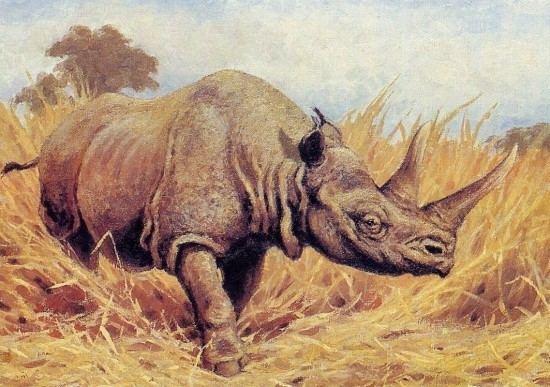Family Rhinocerotidae | Phylum Chordata Order Perissodactyla Rank Genus | |
Similar Dihoplus kirchbergensis, Stephanorhinus etruscus, Stephanorhinus hundsheimensis, Coelodonta, Stephanorhinus hemitoechus | ||
Modelo 3d de stephanorhinus etruscus la rioja junio 2015
Stephanorhinus or Merck's rhinoceros is an extinct genus of rhinoceros native to northern Eurasia that lived during the Lower to Early Late Pleistocene epoch. It had two horns and was a relatively large rhino. It weighed over 3,000 kg (6,600 lbs) and measured about 2.00 metres (6.56 ft) tall and 4.00 metres (13.12 ft) in length, having a size similar to a white rhino.
Contents
Species and distribution

In the Late Pleistocene, there were two species of Stephanorhinus in Eurasia, the large Merck's rhinoceros (Stephanorhinus kirchbergensis) and the narrow-nosed rhinoceros (Stephanorhinus hemiotoechus). Both species may have evolved from Stephanorhinus etruscus. However, it remains unclear whether another species, Stephanorhinus hundsheimensis, also fits in this evolutionary line. This rhino, which lived in the Early and Middle Pleistocene in the western Palaearctic, could also have been a European side branch, derived from the Pliocene rhino Stephanorhiuns jeanvireti. It was probably a relatively unspecialised animal, evolved for grazing and browsing. When about 600,000 years ago the two new rhino species S. kirchbergensis and S. hemiotechus arrived in Europe, it disappeared. The arrival of a specialised browser and a specialised grazer was probably hard competition for this generalist.

S. kirchbergensis preferred forest or woodland habitats, while S. hemitoechus was probably adapted to more open habitats. S. kirchbergensis is relatively rare in fossil record and known from few Italian, French, German, British, and East-European localities, mostly of the middle Pleistocene. In Asia it is known from Siberia, Central Asia (e.g. southeastern Kazakhstan), Central Korea, and China. It may have also occurred in Israel and Lebanon, but here it is unclear if it was really S. kirchbergensis or a similar species. In eastern China, S. kirchbergensis was present throughout the Pleistocene between 30°N and 40°N.

In eastern Europe S. kirchbergensis disappeared during the earliest Late Pleistocene, where it is recorded in the Eemian in Poland. In the forests of the Caucasus it may have survived even until the early Weichselian. The last occurrences are known from Spain, where it survived until the middle or early Late Weichselian. The narrow-nosed rhinoceros appeared in Europe in the early Middle Pleistocene. It is known here from many localities between, Spain, Italy, Germany and the British Islands. Apart from Europe it is also known from Syria, Israel, the Caucasus and from one Late Pleistocene locality close to Lake Baikal. This is the easternmost point of the known range. The latest fossils of the narrow-nosed rhinoceros are known from the Balkan, where it survived until the early late Weichselian.
